by Dave Belcher
Isaac Albéniz: A Portrait
This article offers a portrait of Isaac Albéniz. Around the new year a couple of members from Classical Guitar Corner Academy decided it would be great to dedicate more time to learning about guitar composers. So they made a New Year’s Resolution for 2019 to dedicate one month each to a different composer. This “Composer of the Month Club” would allow CGC Academy members to learn more about each composer’s history, achievements, and especially their music. Many members have been contributing and participating by sharing videos, posting tidbits of history of the featured composers, and interacting with other members’ insights. January featured the great Spanish composer Isaac Albéniz. So we thought it would be great to share a bit of background about this great composer with you. Thanks to the efforts of our brilliant Academy members (especially to Barbara and Mark!).
Albéniz and the Guitar
Isaac Albéniz is a well-known figure to the classical guitar community. Many of his works are well-established in the guitar repertoire and some of these pieces, like “Asturias” (Leyenda/Preludio), are now better known and more frequently performed on the guitar than on the piano, for which they were originally composed. And so it may come as a surprise to those who didn’t know that Albéniz never composed for the guitar. The bulk of those pieces that have become standards in the guitar repertoire — Suite Espanola, Piezas Caracteristicas, Chants d’Esapgne, some selections from Iberia — are thanks in large part to arrangements made by Francisco Tárrega and his most famous student, Miguel Llobet (and then later Andrés Segovia, John Williams, Manuel Barrueco, and many, many others).
Albéniz and Tárrega
Even though Albéniz never wrote for the guitar, these arrangements were actually not unknown to the composer — Albéniz and Tárrega were close friends and Albéniz knew and heard Llobet perform as well. In a biography of Tárrega by Emilio Pujol (yet another well-known student of Tarrega’s), the author remarks that Albéniz heard Tárrega perform the latter’s arrangement of his “famous Serenata” (that is, Granada) and upon hearing it exclaimed, “This is what I had conceived!” Perhaps Albéniz was referencing in particular the strummed chords at the beginning of the piece. Albéniz had written about Granada in a letter to his friend Enrique Moragas,
I seek now the tradition, which is a gold mine, the guzla, the lazy dragging of fingers over the strings (quoted in and translated by Walter Aaron Clark, “Francisco Tarrega and the Art of Guitar Transcription,” 18).
The “guzla” was an ancient Moorish stringed instrument. The guitar echoed the guzla as it accompanied the cante jondo style of traditional Spanish songs by strumming along. This is not unlike the arpeggiated chord rolls that introduce the gentle, lilting melody of Granada’s serenade.
“Granada, Serenata” (arr. Francisco Tárrega; Javier Riba, guitar)
Albéniz and Llobet
There is also evidence that Albéniz later heard and approved of Miguel Llobet’s performance of arrangements of Albéniz’s piano pieces for the guitar. So, while Albéniz never himself composed for the guitar, there seems to be clear influence of the guitar upon his compositions and he also found the guitar a suitable instrument for performing his music.
“Evocacion” from Iberia (arr. Miguel Llobet; Miguel Llobet and Maria Luisa Anido, guitars)
Academy member Barbara Ryan, who started the Composer of the Month Club, had this to say about Albéniz’s legacy on the guitar:
I was most surprised
by the significance of Albeniz’s classical guitar legacy given that he did not play or compose for the guitar, and I really had not appreciated the enormous personal impact he had on Segovia and Tárrega and others who were the giants of classical guitar.
Albéniz and the Piano
Nevertheless, Albéniz holds renown for his piano compositions. Born in the Catalan town of Camprodon on May 29, 1860, Albéniz was a child prodigy on the piano, giving his first public performance at age four and first publishing one of his earliest compositions, “Marcha militar,” at the age of eight. The greatest European composers (and especially pianists) of the time influenced him the most, and he yearned to study with Franz Liszt. He even traveled to Budapest to meet and study with the master, but Liszt was away in Weimar at the time. His earliest compositions reflect the influence of Liszt, Chopin, Beethoven, and others.
“Concierto Fantastico” (Aldo Ciccolini, piano; Enrique Batiz, conductor; Mexico City Philharmonic Orchestra), with clear influence of both Chopin and Schumann.
The spirit of the Spanish people and its music heavily impressed Albéniz. He sought to convey this same spirit in his own music. The bulk of his music arranged for the guitar — especially the Chants d’Espagne and the Suite de Espanola — comes from this period in Albéniz’s output and mirrors the “salon” style of Pedrell. These are short, simple pieces that reflect the character and variety of Spanish popular music of the time.
It is perhaps fitting that this music, so heavily influenced by Pedrell and Spanish musical nationalism, has become so popular on the guitar, as Pedrell studied with the great Romantic guitarist Jose Broca, who himself studied under the Classical Spanish guitarist Dionisio Aguado — so there is a direct line from Aguado to Albéniz.
Iberia
Prior to participating in Albeniz January, I had never heard of Iberia (much to the chagrin of my Spanish colleague at work, who now is convinced that I must have grown up under a rock). Like many
guitarists, I was only aware of him through guitar transcriptions of his earlier works, and had no idea that “Iberia is the wonder for the piano; it is perhaps on the highest place among the more brilliant pieces for the king of instruments” (Olivier Messiaen). Unlike those early piano works, Iberia is far too complex to be transcribed for solo guitar, although it was arranged for guitar trio during Albeniz’s lifetime, much to the composer’s delight. Recent recordings for guitar trio and quartet are available, which I highly recommend.
Albéniz’s later musical output is best known for his work — really his masterpiece — Iberia: 12 Impressions in 4 Books, which was heavily influenced by modernist and impressionist techniques he acquired while living in France. But truthfully Iberia is a more-than-an-hour-long work that pulls together all of Albéniz’s musical influences into a musical language that is distinctly his own. The pieces are heavily influenced by Andalusian dance music, with musical forms as diverse as the fandango, malaguena, rondena, bulerias, sevillanas, guajiras, saeta, zapateado, soleares, and even an habanera making an appearance (drawing upon his youthful visit to Cuba with his father). These pieces are also heavily influenced by mainline European music, with no less than eight of the pieces in traditional sonata form, and modernist and impressionist language is suffused throughout. Albéniz often joins these two influences together with yet another: coplas, or lyrical Spanish songs.
Thus, while the classical guitarist may know Albéniz more from Asturias or Granada, it is through Iberia, a heavily pianistic work, that Albéniz became one of the most important composers in Spanish history.
Iberia (Alicia de Larrocha, piano)
***
We hope you’ve enjoyed this portrait of Isaac Albéniz. This blog article is thanks to the members of Classical Guitar Corner Academy. We hope you’ll join the Academy today!

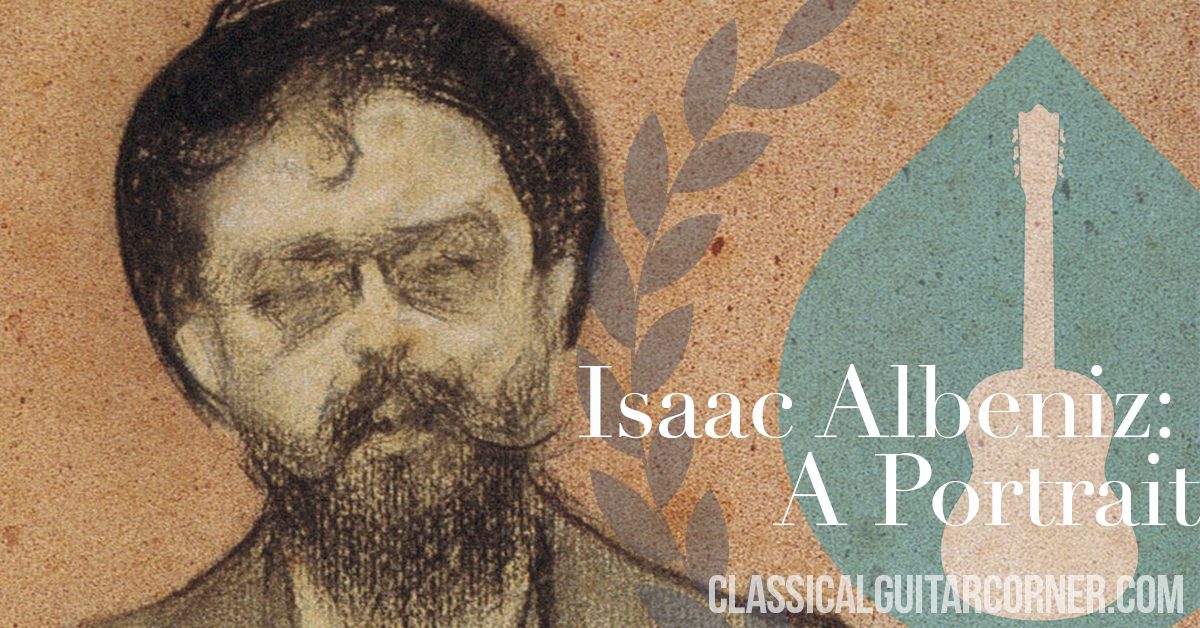
 by the significance of Albeniz’s classical guitar legacy given that he did not play or compose for the guitar, and I really had not appreciated the enormous personal impact he had on Segovia and T
by the significance of Albeniz’s classical guitar legacy given that he did not play or compose for the guitar, and I really had not appreciated the enormous personal impact he had on Segovia and T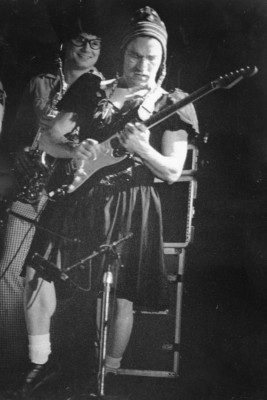 guitarists, I was only aware of him through guitar transcriptions of his earlier works, and had no idea that “Iberia is the wonder for the piano; it is perhaps on the highest place among the more brilliant pieces for the king of instruments” (Olivier Messiaen). Unlike those early piano works, Iberia is far too complex to be transcribed for solo guitar, although it was arranged for guitar trio during Albeniz’s lifetime, much to the composer’s delight. Recent recordings for guitar
guitarists, I was only aware of him through guitar transcriptions of his earlier works, and had no idea that “Iberia is the wonder for the piano; it is perhaps on the highest place among the more brilliant pieces for the king of instruments” (Olivier Messiaen). Unlike those early piano works, Iberia is far too complex to be transcribed for solo guitar, although it was arranged for guitar trio during Albeniz’s lifetime, much to the composer’s delight. Recent recordings for guitar 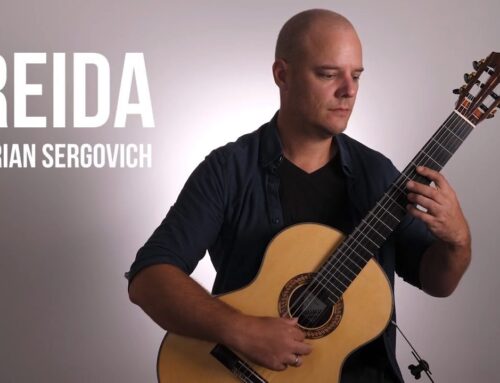
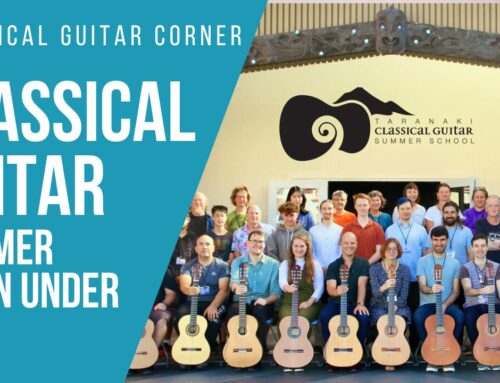
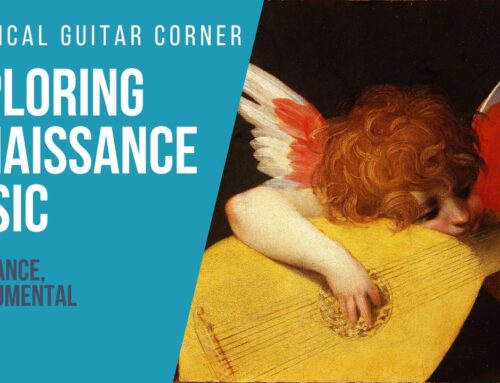
[…] discuss a new composer each month. During January members discussed and studied Spanish composer Isaac Albéniz. For the month of February the Composer of the Month Club featured Elizabethan Renaissance composer […]
Thank you so much, I had no idea Albeniz wrote for piano. So much to learn!
[…] If you would like to read more about the composer, Issac Albéniz, you can read Dave Belcher’s excellent article: Issac Albéniz : A Portait. […]